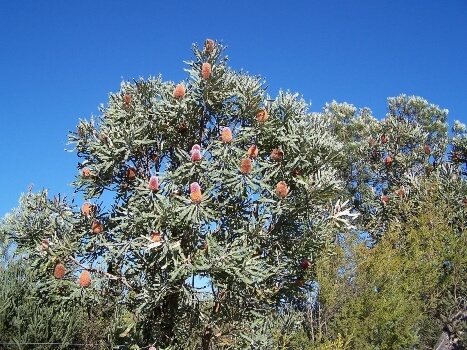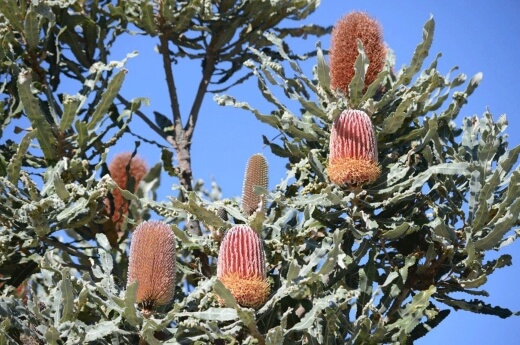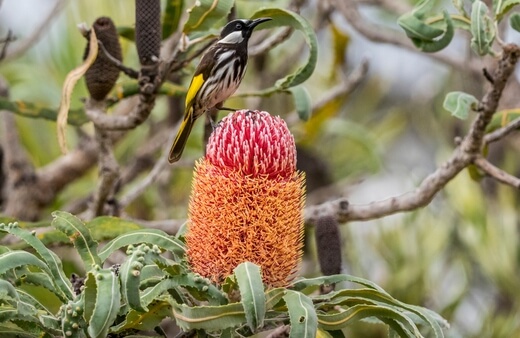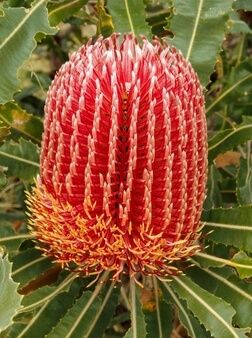Any plant that is part of the protea family like the Banksia menziesii is a personal favourite of mine. There is something about the structural beauty of the plant and its flowers that makes me want to fill my garden with them. It’s also the type of plant that I choose to give to others the most.
In our how to grow and care guide, we’ll officially introduce you to the Banksia menziesii, talk about how to propagate the shrub from seed or cuttings, how to care for your plant, pests and diseases to be aware of, and some frequently asked questions.
More...

Source: Wikipedia
Family: | Proteaceae |
|---|---|
Genus: | Banksia |
Species: | B. menziesii |
Common Names: | Menzies Banksia, Firewood Banksia |
Location: | Outdoor |
Type: | Tree or shrub |
Growth: | Up to 10 metres tall, Up to 8 metres wide |
Sun requirements: | Full sun |
Foliage Colour: | Grey green |
Flower Colour: | Yellow, red, pink, orange |
Flowering: | Autumn, Winter, Spring |
Fruit: | Woody cone |
Maintenance level: | Low |
Poisonous for pets: | No |
Introducing Banksia menziesii
The Banksia menziesii belongs to the Proteaceae family and certainly looks like its relations - you can see the obvious resemblance with other proteas. This tree or shrub is found mainly in Western Australia.
You’ll find it naturally occurring in the sandy coastal plains. In terms of size, it can reach a height of up to 10 metres and can spread across up to 8 metres.
The leaves of the Banksia menziesii are a lovely grey green colour and it produces large flowers which often have a two tone colour effect. You can expect reds and pinks, cream and gold, and even a bronze and burgundy colour.
How to Grow Banksia menziesii

If you want to propagate your own, the Banksia menziesii grows well from seed and can germinate in around 6 weeks. This plant can regenerate itself well after a fire, which actually helps to release seed for germination.
The flowers of this shrub are great as cut blooms in a vase and for decorative purposes. If you’re looking for a more compact Banksia menziesii for your garden space, there is a dwarf variety available that reaches a maximum height of 2 metres.
Propagating Firewood Banksia
How to Propagate Firewood Banksia from Seeds
For seed extraction, you can place the cones on a tray in the oven for about an hour on low heat. You should notice that the follicles start to open. You can then tap the seeds out or lift them out with tweezers. The seed is a black colour and has what looks like brown paper wings.
We don’t recommend putting the cones in the microwave to achieve this process. You can put the seed cones on a fire and take out the seeds when the follicles open up and could also soak the cone in water, and then heat in the oven.
Banksia menziesii seeds don’t need any pre-treatment before sowing. When preparing your potting mixture, make sure that it’s slightly acidic. It needs to be free draining but also should be able to hold moisture.
A great recipe we’ve discovered for this is a mixture of fine and medium pine bark, coarse sand and sieved peat moss. Ensure that there is enough air circulation for the germination process and keep the mixture moist but not soggy.
(Our previous advice included the use of peat/sphagnum moss. However, due to its environmental repercussions, we've realigned our suggestions to highlight alternative options that are just as effective, if not better. Don't miss our comprehensive guide to learn more about peat moss and its alternatives.)


Get Your Free Guide:
Master Growing Australian Natives eBook
A Must Have Complete Guide for Every Australian Garden
Get Your Free Guide:
Master Growing Australian Natives eBook
A Must Have Complete Guide for Every Australian Garden
You’ll need a fairly deep container allowing the water to drain through the mixture. Sow your seeds and just slightly cover them. You can then mist them with a water spray.
Place your seed container in a place that is warm and sheltered and just remember to keep your mixture moist. You should start to see signs of germination within 3 to 6 weeks.
A great way to prevent fungus from getting hold of your seedlings and spreading spores is to water them from below. You can achieve this by putting the seed tray on some sand and then watering the sand so that the water can be absorbed.
If you’ve been growing a few seedlings in one pot, you’ll need to prick them out after germination before the roots get too big and become damaged in the pricking out process. They can then be transferred to individual pots.
They will need to be hardened off before they can be planted into the garden. You can do this process for around 2 weeks keeping them sheltered. Again, keep them moist and you can give them a half strength fertiliser.
Once the hardening off process is done, you can then plant your new seedlings somewhere sunny in your garden.

Propagating Menzies Banksia from Cuttings
The length of your cutting should be around 16cm and you want to make the snip just below a leaf node. Don’t let the cutting dry out and try to propagate as quickly as possible.
As with the seed process, you want to use quite a deep tray to allow for good drainage. Take the leaves off the lower half of the cutting, removing up to about two thirds.
Next, you can dip the cutting into rooting hormone and give it a gentle shake. Make a hole in the potting mixture and the cutting should be planted about half way down. You can plant a few cuttings together if you like. Just ensure they have sufficient space for air circulation.
Give your cuttings enough water once planted. Misting is a good way to make sure the potting mixture stays moist enough and creates humidity for the cuttings, keeping the temperature down.
This actually helps root development of the plant. The temperature range you’re aiming for is between 20-27°C for day time and around 15°C at night.
Good air circulation around the cuttings helps to prevent fungus and mould from developing. Make sure to maintain the correct light levels and ensure your cuttings get enough. If the leaves start to look pale and bleached, it’s a sign of too much sunlight.
Banksia menziesii cuttings should develop roots around 8 to 10 weeks after planting. As with the seedlings, you will need to do a hardening off process with the cuttings before they head outside to avoid shock and setback in terms of the new growth.
Caring for Banksia menziesii
Sunlight
Banksia menziesii is a bit of a sun worshipper and needs a good dose of full sun daily in order to thrive.
Watering Firewood Banksia
While the Banksia menziesii is still establishing itself you can give it regular watering for the first 2 years. Once they have matured you don’t need to water much at all as too much water will do more harm than good. You can do a good watering if the weather becomes hot and dry.
Best Soil to Use
If you look at how Banksia menziesii grow in nature, you’ll know that they need a soil that is light and well-draining. Adding compost to the soil is an added bonus and a sandy type of soil is perfect.
For a more clay soil, you can add in lots of finely chopped bark which can help with the texture of the soil. You could even plant your shrub at a slight elevation to help with drainage.

Source: Australian Native Plants
Pruning
Banksia menziesii can be a tricky one to prune. Light pruning is great, but if you do too much, you’ll end up with an abundance of leaves and not many flowers. If you do a heavy pruning into the old wood of the shrub, it can cause permanent damage.
Usually pruning is done lightly just to keep the right size and shape. Refer to our review to get the best pruning shears available online.
Fertilisering Banksia menziesii
When it comes to fertilising your Banksia menziesii, you’ll need to remember that the plant doesn’t like high levels of phosphorus. You could use something like an organic mulch or go for a light application of a slow-release fertiliser that is made for native plants.
You can fertilise when you plant your shrub and thereafter can feed the plant once a year. More than that isn’t necessary.
Fascinated with Bankias? Check out our in-depth guide for growing banksias and discover its different varieties.
Common Firewood Banksia Pests and Diseases
Powdery Mildew
Powdery mildew loves humidity and will easily spread. You can use an organic fungicide for treatment – aim for one that has sulphur, neem oil or potassium bicarbonate.
Try and apply treatment as soon as you first notice the disease on your shrub. Some gardeners have also shared that baking soda is an effective treatment.
Aphids
Aphids are small sap-sucking insects that vary in colour. The best way to keep aphids under control is to blast them with a strong stream of water. Even rain that is hard enough can dislodge them, and they don’t come back after that.
Crown Gall
This disease is caused by a bacteria in the soil and this causes abnormal growth on the roots and branches. The best way to treat the soil is by using heat. A steam application for 30 minutes will do the trick.
Rust
This disease is caused by a fungus that feeds on the living plant tissue. Dusting sulphur on the plant can help to treat and prevent the disease. Neem oil is also effective and some say combining the oil with baking soda is a great option.
Root rot
If you notice that your plant is growing slowly, that the stems are mushy, and that leaves are yellow and wilted, it could possibly be root rot. The soil might be smelly and the roots could be a red brown colour.
You’ll need to remove the plant from the ground or pot, remove the soil around the roots, trim away any rotten parts and leaves, and if in a pot, get rid of the soil and thoroughly clean the container.
Banksia menziesii Frequently Asked Questions

Where does Banksia menziesii get its name from?
Banksia is named after Sir Joseph Banks. He was a well-known English botanist and made many plant discoveries. The name Menziesii is to honour Archibald Menzies. He was a surgeon and naturalist on board the HMS Discovery.
It was on this trip that they discovered the King George Sound. The plant Banksia menziesii was only officially discovered later and so Archibald Menzies never actually got to see it himself.
Is Banksia menziesii considered fast growing?
It is a quick growing shrub and easily releases its seeds after a fire.
How many species of Banksia are there?
There are about 170 different species and all of them except one are native to Australia.
Where does the common name firewood banksia come from?
The plant is quick burning and hence earned itself this name.
What is Banksia menziesii called in the cut flower industry?
Strawberry and raspberry frost Banksia.
Has the Banksia menziesii been featured anywhere famous?
This particular plant was actually featured on a series of plates made by Wedgwood in the early 1990s.
Need to read up on more plants to make the right decision for your garden? Subscribe to our newsletter for regular updates on all things gardening.
Wrapping Up Our Banksia menziesii Growing and Care Guide
Growing Banksia menziesii is super easy for any gardener. The winning formula is a well-drained soil, full sun and great air circulation. If you live in a moist and humid climate, this shrub might not be the right choice for you.
Overall, the Banksia menziesii is an incredibly hardy plant and doesn’t need much attention.
Published on December 26, 2022 by Gary Clarke
Last Updated on January 19, 2025




